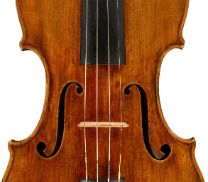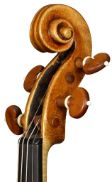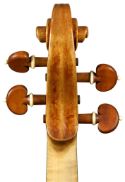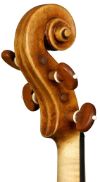Violin, Giuseppe Guarneri del Gesù, Cremona, 1731, “ex Sorkin”
Printed label: “Joseph Guarnerius fecit [cross] / Cremonę anno 1731 IHS” (31 handwritten)Shortly before 1730, Giuseppe Guarneri del Gesù began to affix his own labels to his violins. The “ex Sorkin” is one of the instruments he built early in his career. It has many features typical of his personal style that distinguish him from his father, Giuseppe Guarneri filius Andreae. As the corners of Guarneri del Gesù’s violin model are short, the C-bouts have a very open appearance. Del Gesù also evolved his own style of carving the arching. His instruments have lower arches than those of his father; moreover, the arch is graduated differently. It begins close to the edge, so that the fluting channel is shallow or almost nonexistent, which lets the arch appear broader and fuller. Additionally, del Gesù’s backs are rather thick in the middle. Probably all these characteristics together are responsible for the sonority of his instruments. The halves of the two-piece belly of the 1731 violin are not from the same log. A dendrochronological analysis determined that the youngest tree ring was from 1719. The belly is of very fine-grained wood with somewhat irregular growth. The two-piece, quarter-cut back has fairly tight flames in a V shape. The ribs are also intensely flamed, whereas del Gesù used unflamed maple for the scroll and pegbox. The medium-high arching extends very close to the edge and transitions suddenly to the narrow fluting channel. The f-holes with their small eyes are reminiscent of Stradivari’s style, but the wing size and shape are different. The upper wings are especially wide. The purfling is even and slender, making it appear delicate. The pegbox and scroll are well-proportioned and cleanly carved. Compared to later work, the scroll is sculpted very symmetrically. Toolmarks typically found in many of del Gesù’s instruments are evident, above all in the deeply cut volutes. The violin has a deeply reflective golden-yellow ground. The color varnish is mainly preserved in the low-lying areas of the back plate. The conical hole typically found on del Gesù’s instruments can be seen on the back of this violin as well.
The earliest documented owner of this violin is violinist Mischa Mischakoff, who was born in Imperial Russia in a town that lies in Ukraine today. He escaped from Russia in 1921 and obtained US citizenship in 1927. Mischakoff played in various orchestras, holding the position of concertmaster of the NBC Symphony Orchestra in New York under Arturo Toscanini from 1937 to 1952. A certificate by W. E. Hill & Sons shows that he already played the 1731 Guarneri violin at this time. In the 1960s, Leonardo Sorkin, the founder of the Fine Arts Quartet, played the del Gesù. After Sorkin’s death, a Dutch foundation purchased the instrument to lend it to the concertmaster of the Concertgebouw Orchestra in Amsterdam. From 1997, the violin was briefly part of Herbert Richard Axelrod’s collection.
Borrower: Alexander Janiczek












